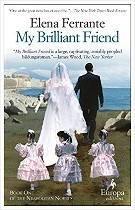 Elena Ferrante •
Elena Ferrante •
My Brilliant Friend •
Remember the game of Town that Harriet the Spy devises? She marks out an entire municipality under a tree, invents 25 characters, gives them backstories, and moves them around in relation to one another.
Ferrante’s Town is a working-class section of Naples following the Second World War. The same families have lived here for generations, passing down feuds and alliances, rumors and grudges, as part of their common tapestry. Blood and violence permeate daily life. Lenù, the narrator, enumerates the many things that can kill you: tetanus, tuberculosis, falls, bombs, sharks, swallowing cherry pits or American chewing gum, even getting hit on the temple—in a neighborhood where “throwing stones was the norm.”
Her friendship with Lila, the local “it” girl, begins on the day Lila drops Lenù’s beloved doll into a deserted cellar. Lila is fierce, reckless, unforgiving—everything Lenù is not. “You have here a girl who will become more beautiful than a Botticelli Venus,” declares a stranger in a café.
Lenù wins academic honors, but the triumph is hollow after Lila has left school to work. When Lenù pens an article for publication, it’s Lila who rewrites it. Lenù acquiesces without a murmur, knowing her friend’s intellect to be superior to her own.
The plot advances in bursts, each short chapter centered on one event or interchange. There is an inevitability to the action, as if it could not happen any other way: the rainstorm, the visit to the seaside, the shooting on New Year’s Eve, the design of a pair of shoes. The book closes with Lila’s wedding at age 16, and one tiny occurrence that is certain to trigger an avalanche in the next volume of the four-part series.
Don’t miss this tour de force; it’s unlike anything you will read again.





This whole series, an absolute favorite. Did you see the video serialization, the details very true to the books.